Luna-Resurs (original) (raw)
Searching for details:
The author of this page will appreciate comments, corrections and imagery related to the subject. Please contact Anatoly Zak.
Read more on:
Related pages:
See also:
Luna-Resurs project
According to the original plan, Luna-Resurs was to be the second post-Soviet robotic mission to the the Moon. At one point, Luna-Resurs was a joint project with India, but, eventually the European Space Agency, ESA took the role of the main international partner in the project, which had a main goal of examining the distribution of volatilities, such as water, in the lunar surface, which would be crucial for both, the scientific understanding of the Moon and for the future of space exploration.
Previous chapter: Luna-Glob
Multi-phased program
With the improvement of the Russian economy in the second post-Soviet decade, Russia started developing a multi-step program for the unmanned lunar exploration. According to that strategy, the first Luna-Glob lunar orbiter could be followed by a lander, which was initially known as Luna-Glob-2 and was later designated Luna-Resurs. A standard lander developed for the Luna-Resurs project could be reused for further missions to the Moon and beyond. Luna-Resurs was expected to be followed by the Luna-Grunt dual mission, which would carry a rover and the ascent stage to return lunar samples back to Earth. Hardware developed for Luna-Glob, Luna-Resurs and Luna-Grunt missions could ultimately be used to establish the so-called Lunny Poligon (Lunar Range), featuring a series of stationary and movable facilities on the surface of the Moon.
Cooperation with India
On October 4, 2006, Anatoly Perminov, head of Roskosmos, discussed space cooperation with Indian officials. One option considered at the meeting was Russian participation in the second Indian lunar mission -- Chandrayaan-2 -- then planned for launch in 2010 or 2011. According to initial reports, NPO Lavochkin would develop technology for taking lunar soil samples for the probe. On Nov. 12, 2007, during Indian Prime Minister Manmohan Singh's visit to Moscow, Russia and India signed an agreement on lunar exploration. According to the plan penned by Perminov and Madhavan Nair, secretary of India's Department of Space and chairman of the Space Commission, in 2011, India would launch a lunar probe which would carry a 400-kilogram lunar rover built in Russia.
The political agreement between Russian and Indian government on lunar exploration came as a surprise to planetary scientists, at least to those on the Russian side. In a recently established management style, the agency's leadership did not coordinate its decision either with developers of the Luna-Glob mission or with the Space Council of the Russian Academy of Sciences which traditionally formulated the country's science program in space. As a result, scientists and engineers had to fit scientific goals into a political circumstances. It would take years and many revisions.
The initial plan, agreed upon by heads of agencies, called for the launch of the Indian Chandrayaan-2 spacecraft onboard the Indian GSLV Mk-II rocket. A Russian-built rover would ride to the Moon along with an Indian orbiter. In addition, Russian instruments would be installed on the Indian orbiter.
On the Russian side, the Chandrayaan-2 project was added, but did not replace the yet-to-be launched Luna-Glob mission. As a result, the new project also received a Russian name -- Luna-Resurs -- and it was expected to fly after Luna-Glob. Specifically for the Chandrayaan-2/Resurs-2 mission, NPO Lavochkin started the development of a new-generation lander, which could be used for follow-on Russian missions, such as a landing on the Jupiter's moon Europa after 2020.
Upon evaluating the mission scenario of the Chandrayaan-2/Resurs-2 mission, Russian scientists thought it could be tied to their own designs to form a multi-mission scenario, which could deliver soil samples from the Moon. According to the Russian proposal, the rover developed for the Russian-Indian project would be used to gather soil samples, which would then be sent to Earth by a separate vehicle developed within the Luna-Grunt project. The Russian-built Luna-Glob orbiter would support both missions, serving as a data relay station in lunar orbit. At least two variations of such a mission were drafted at NPO Lavochkin. A second, bolder version of the plan, called for launching Luna-Glob and Chandrayaan-2 orbiters on a single Russian rocket, thus freeing the payload mass onboard the Indian rocket for the lander and a rover. However negotiations with India on this plan proved fruitless. Most likely, India feared that a three-launch scenario would tie the Chandrayaan-2 mission to many budgetary and technical risks, jeopardizing the main political goal of the program -- to beat China to the Moon.
Scientific goals: search for lunar water
Despite disagreements on the mission scenario, Russian planetary scientists mulled an ambitious goal for a cooperative lunar mission with India – the search for water ice. The hard-to-achieve but potentially critical for the future of space exploration task of touching lunar water was to be discussed during a visit of the Indian delegation to Moscow in March 2009. "We wanted this mission to be not simply a technological project aiming to insert a satellite in orbit around the Moon and to land another one on its surface, but rather have this pair of an orbiter and a lander accomplish a fundamental scientific task," says Aleksandr Zakharov, the deputy director of Moscow-based Space Research Institute, IKI. Russian scientists narrowed the scientific goals of the project to two major fields – seismic research and exploration of polar regions of the Moon. The latter goal became especially attractive to planetary scientists in 1990s, after a US probe found signs of water ice around the lunar poles. By proving the existence of water on the Moon, researchers would not simply write an important page in the geological history of the Earth’s natural satellite, but would also provide a major boost to any future efforts to establish a habitable base on the Moon. In 2006, NASA chose Shackleton Crater near the South Pole of the Moon as the likely address for a permanently occupied outpost.
Scientists however were yet to sample ice on the Moon and the race was on for what could be one of the major scientific breakthroughs of 2010s. Probing lunar ice would not be easy. Any significant amounts of ice are probably accumulated on the floor of deep polar craters, known as "cold traps," which have not seen sunlight for eons. "We are trying to see if a rover can help us (reach the lunar ice)," Zakharov said, "However, we are facing very low temperatures inside those depressions and it is not likely that a regular rover would work. However, we are searching and discussing the possibilities of what could be done (within the scope of the project)."
When the head of Roskosmos, Anatoly Perminov, and Madhavan Nair, secretary of India's Department of Space and chairman of the Space Commission first penned the agreement on the Chandrayaan-2 mission, it promised to lift off in 2011. However after two years of planning and with the new challenging goals scientists had brought to the table, the project would be pushed back as far as 2015. In the meantime, pressure from China, which by the beginning of 2009 had announced its plans to land the Chang'e-3 mission on the Moon in 2013 soon dawned on India. The plans had to be streamlined to enable an Indian "response" within the same time frame. During 2009, a launch in 2012 was under consideration.
The 2010 mission scenario
By May 2010, the Russian-Indian lunar mission was scaled down to include an Indian-built orbiter and a 1,260-kilogram Russian lander carrying a 15-kilogram Indian rover. The latest mission scenario was made official in Protocol No. 1 of the Russian-Indian agreement on April 1, 2010. (444) Around 35 kilograms would be available for Russian payloads onboard the lander. The scientific package on the lander would include a Russian-built robotic arm and, possibly, a drill, which could penetrate as deep as one meter below the surface. Plans for including a larger Russian rover were dropped for this mission.
An Indian GSLV Mk-II rocket would still launch Chandrayaan-2/Luna-Resurs from an Indian launch site inserting it into a highly elliptical orbit around the Earth (170 by 37,000 kilometers; an inclination 44 degrees). The engine onboard the Indian orbiter would then have to be fired three times to propel the orbiter/lander tandem toward the Moon. After an 80-hour joint flight, the two vehicles would separate and fly the rest of their respective missions separately.
The lander was expected to cover the distance between the Earth and the Moon in 4.5 days. Two orbit corrections would be conducted on the way. As the lander approached the Moon, another engine firing would place it into a circular orbit around the Earth's natural satellite. Two days later yet another orbital maneuver would form a preliminary landing orbit. An additional engine firing could be conducted as necessary based on the latest trajectory measurements. Finally, the spacecraft would initiate a braking maneuver leading to a descent to the lunar surface. The initial phase of the descent would culminate with a high precision landing from an altitude of 20 meters above the lunar surface with a constant descent velocity of three meters per second. (440)
During a one-year mission, the Russian lander would use X-band and an Indian mini-rover S-band for communications with Earth.
As of the middle of 2010, the official launch date was quoted as 2013. By the beginning of 2011, the planned launch window was narrowed to September 2013. (489) Within a year, the Luna-Glob mission would follow Luna-Resurs to the same polar area or to the opposite pole of the Moon, however by 2010 its development was clearly pushed behind Luna-Resurs in priority.
Scientific program for Luna-Resurs and Luna-Glob
On April 15, 2010, the Space council of the Russian Academy of Sciences signed Decision No. 10310-09 to reconfigure the Luna-Glob mission and coordinate development of its lander with that of the Luna-Resurs project. (444) From May to September 2010, the Space Research Institute, IKI, conducted a competitive selection of scientific instruments for both missions. A package for chemical analysis of lunar regolith, including traces of water, seismic instruments and a radio beacon, which could facilitate future landings, were among candidates for the mission. Out of total 31 proposals, 24 instruments were selected as candidates based on a meeting of independent technical and scientific experts on April 23, 2010.
On June 17, the primary investigators of the proposed experiments onboard Luna-Resurs and Luna-Glob presented their projects at a scientific and technical meeting at Space Research Institute, IKI, Moscow. From July 7 to Aug. 31, science teams defended the proposed versions and feasibility of their instruments at special hearings which included independent experts, representatives of quality control at IKI and Division 5507 for military certification within the Ministry of Defense. The findings of the expert commission were reported to the meeting of the Planets and small bodies of the Solar System sub-section within the Academy of Sciences Council on Sept. 2, 2010. At the meeting, an official final selection of instruments was made for the Luna-Resurs mission.
A total of up to 10 instruments would be onboard. The Indian space agency, ISRO, did announce a seven-instrument scientific payload for the mission on Aug. 30, 2010:
Orbiter payloads:
- Large Area Soft X-ray Spectrometer (CLASS) from the ISRO Satellite Centre, ISAC, based in Bangalore;
- Solar X-ray monitor (XSM) from the Physical Research Laboratory, PRL, based in Ahmedabad. The instrument was designed for mapping the major elements present on the lunar surface;
- L- and S-band Synthetic Aperture Radar (SAR) from the Space Applications Centre, SAC, in Ahmedabad, for probing the first few tens of meters of the lunar surface for the presence of different constituents, including water ice. SAR is expected to provide further evidence confirming the presence of water ice below the shadowed regions of the moon;
- Imaging IR Spectrometer (IIRS) also from SAC for mapping of lunar surface over a wide wavelength range for the study of minerals, water molecules and hydroxyl present;
- Neutral Mass Spectrometer (ChACE-2) from the Space Physics Laboratory, SPL, based in Thiruvananthapuram, to conduct a detailed study of the lunar exosphere;
- Terrain Mapping Camera-2 (TMC-2) from SAC, which would be used to compile a three-dimensional map essential for studying lunar mineralogy and geology;
Lander payloads:
- Laser induced Breakdown Spectroscope (LIBS) from the Laboratory for Electro Optic Systems, LEOS, in Bangalore;
- Alpha Particle Induced X-ray Spectroscope (APIXS) from PRL, Ahmedabad;
Mission changes approved
On Dec. 8, 2010, the Scientific and Technical Council at NPO Lavochkin conducted a formal defense of amendments to the preliminary design of the Luna-Resurs mission. The meeting reviewed changes to the mission plan and a possible coordination between the Luna-Resurs and Luna-Glob missions, the company's web site said. According to the company, beyond formal approval of changes to the preliminary design, the gathering also "clarified a set of onboard service systems and payloads, as well as ballistic and navigational issues of the mission.
India ends cooperation with Russia on Luna-Resurs
Following the Phobos-Grunt launch fiasco in 2011, all planetary exploration and science projects in Russia faced uncertain future. Luna-Resurs and Luna Glob missions were now expected to fly no earlier than 2016 or 2017. According to unofficial sources, both projects were reverted back to the experimental phase, making possible another major redesign of the missions. In the meantime, in April 2012, the Indian space agency, ISRO, announced that Luna-Resurs would not fly until its GSLV rocket logs two successful missions beginning in September or October 2012.
On August 7, 2014, the Minister of State for Science and Technology of India Jitendra Singh told the Indian parliament that the nation's space agency, ISRO, would launch the Chandrayaan-2 spacecraft on its own, essentially ending the project's dependency on Russia. According to the new design, Chandrayaan-2 will now feature an indigenously built lunar lander, instead of the previously planned Russian platform. At the time, the all-Indian Chandrayaan-2 spacecraft was expected to fly in 2016 or 2017.
Evolution of the Chandrayaan-2/Luna-Resurs project (418):
| - | 2008 | 2010 |
|---|---|---|
| Total spacecraft mass: | ? | 2,650 kilograms |
| Indian orbiter mass: | ? | 1,400 kilograms |
| Lander mass: | Around 1,200 kilograms | Around 1,250 (1,260 (440)) kilograms* |
| Payload mass (not including the rover): | - | 35 kilograms |
| The rover mass: | 50 kilograms* | 15 kilograms |
| Launch vehicle: | GSLV Mk-II | GSLV Mk-II |
*including a 1,210-kilogram "lander with a stationary surface station." (489)
Russian payloads of the Luna-Resurs mission as of end of 2010 (444):
| - | Instrument | Purpose | Developer | Mass, kg |
|---|---|---|---|---|
| 1 | BUNI | Power distribution from power supply system, SES; data collection, storage and transmission; control of science instruments | IKI RAN | 4.0 |
| 2 | Radio beacon | Navigation and positioning on the surface | IKI RAN | 1.7 |
| 3 | TV camera/ spectrometer | TV sensor for UV scanning of mineral composition of the surface | IKI RAN | 0.4 |
| 4 | TV-RPM | TV sensor on remote robotic arm for imaging of working area | RASTR Technology | 0.4 |
| 5 | LIS | Remote sensing in the infrared range of the mineral and water content in the surface layer of regolith | IKI RAN | 0.9 |
| 6 | ANDRON-LR | Study of element composition and hydrogen component in regolith via neutron and gamma spectrometry | IKI RAN | 6.7 |
| 7 | Chromatograph (Block TA-L) | Regolith processing for a chromatograph instrument | IKI RAN | 3.5 |
| Chromatograph (Block GKh-L) | Chromatographic measurement of gaseous components in lunar regolith | IKI RAN | 4.2 | |
| Chromatograph (Block NGMS) | Determination of chemical and isotope composition of the gaseous component in the lunar regolith | IKI RAN | 3.0 | |
| 8 | LASMA-LR | Direct measurements via laser mass spectrometry of chemical and isotope composition of regolith with registration of all chemical elements | IKI RAN | 2.8 |
| 9 | RAT | Measurements of radio brightness of regolith up to a depth of two meters | IKI RAN | 0.5 |
| 10 | PML | Studies of physical characteristics of lunar dust exosphere and surface regolith dissipated under the influence of micrometeorites | IKI RAN | 1.5 |
| 11 | SEISMO-LR | Seismic studies. Detection of seismic signals and wave fields within the lunar lithosphere | IPhZ RAN | 1.0 |
| 12 | ARIES-L | Studies of solar wind interaction with lunar regolith, measurements of solar wind ions reflected from the lunar surface | IKI RAN | 4.1 |
| - | - | - | Total: | 34.7 |
The Luna-Resurs mission chronology:
2006 Oct. 4: Head of Roskosmos, Anatoly Perminov discussed space cooperation with Indian officials.
2007 Nov. 12: Russia and India sign an agreement on lunar exploration, during Indian Prime Minister Manmohan Singh's visit to Moscow.
2010 April 1: Russia and India agree on a new mission scenario for the Luna-Resurs mission with a launch in 2013. (444)
2010 April 15: The Space council of the Russian Academy of Sciences signs Decision No. 10310-09 to reconfigure the Luna-Glob mission and coordinate development of its lander with that of the Luna-Resurs project. (444)
2010 April 23: A meeting of independent technical and scientific experts pre-selects 24 instruments out of 31 proposals. (444)
2010 June 17: The primary investigators of proposed experiments onboard Luna-Resurs and Luna-Glob present their projects at a scientific and technical meeting at the Space Research Institute, IKI, Moscow. (444)
2010 July 7 - Aug. 31: Science teams defend proposed versions and feasibility of their experiments. (444)
2010 Aug. 2: The heads of the Russian and Indian space agencies discuss the Chandrayaan-2/Luna-Resurs mission and other joint projects in Moscow.
2010 Sept. 2: The findings of the expert commission are reported to the meeting of the "Planets and small bodies of the Solar System" sub-section within the Academy of Sciences Council. (444)
2010 Oct. 13: Decision No. 11204/2927-503 of the the Solar System sub-section on the science program of the Luna Resurs mission is sent to Space Council of the Academy of Sciences, RAN, for approval. (444)
2010 Dec. 8: The Scientific and Technical Council at NPO Lavochkin conducts a formal defense of amendments to the preliminary design of the Luna-Resurs mission.
2010 Dec. 16: The Space council of the Academy of Sciences officially approves the composition of payloads for the Luna-Resurs mission. (444)
2011 Sept. 14: Roskosmos issues State Contract No. 361-9870/11 for the Luna-Resurs research and development project, OKR, to NPO Lavochkin.
2013 March 14: Roskosmos and the European Space Agency, ESA, sign an agreement on cooperation in the exploration of Mars and other bodies of the solar system with robotic spacecraft.
2013 Dec. 24: Roskosmos issues State Contract No. 361-9009/13/445 for the Luna-Resurs-1 research and development project, OKR, to NPO Lavochkin.
2015 Aug. 26: Roskosmos and ESA exchange letters on the initial phase in the exploration of the Moon.
2015 Aug. 31: ESA publishes an invitation for a tender to conduct Phase B+ in the development of the Precise and Intelligent Landing using Onboard Technologies, PILOT, system,
2016 June 2: Airbus Defense and Space announces that it signed a contract with the European Space Agency, ESA, at ILA-2016 show in Berlin for early development of the Precise and Intelligent Landing using Onboard Technologies, PILOT, system to be installed on the Luna-Resurs spacecraft.
The design of the Luna-Resurs lander as of the end of 2010.
Next chapter: Luna-Resurs lander
Written by Anatoly Zak; Last update:January 19, 2025
Page editor: Alain Chabot; Last edit: April 22, 2011
All rights reserved
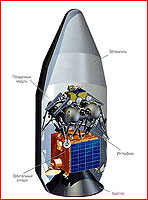
A launch configuration of the Luna-Resurs (Chandrayaan-2) mission with a Russian-built lander and a rover and an Indian-built lunar orbiter launched by a single Indian rocket, as it was invisioned around 2008.
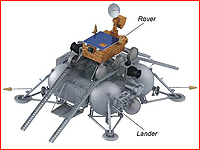
The design proposed circa 2008-2009 of the Russian lunar lander with a rover.
India's GSLV Mk-II rocket was originally expected to launch Chandrayaan-2/Luna-Resurs mission in 2013. Click to enlarge. Copyright © 2008 Anatoly Zak
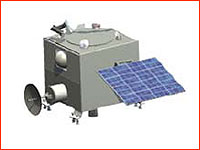
A depiction of a Chandrayaan-2 orbiter as of October 2010. Credit: IKI
The Chandrayaan-2/Resurs-2 lander (top) and the Luna-Glob lander as of August 2010. The drum-shaped solar-panels on the Luna-Glob spacecraft were designed to optimize solar energy input in the polar regions of the Moon, where the Sun rises very low over the horizon. Credit: IKI / NPO Lavochkin
Flight profile of the Luna-Resurs mission as of 2010. Credit: NPO Lavochkin
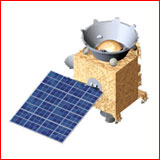
A depiction of a Chandrayaan-2 orbiter circa 2011. Credit: IKI
Artist rendering of the Luna-Resurs lander and an Indian rover on the surface, as it was envisioned by the end of 2010. Credit: IKI / NPO Lavochkin
A launch configuration of the Luna-Resurs mission as of 2011. Credit: IKI / NPO Lavochkin
Main components of the Luna-Resurs mission as of 2010. Credit: IKI / NPO Lavochkin
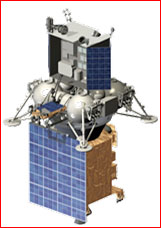
The Luna-Resurs in cruise configuration as envisioned around 2011. Credit: IKI

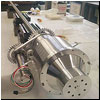
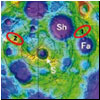
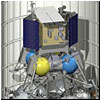
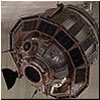
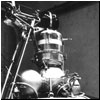
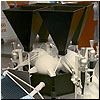
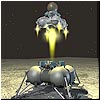
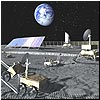


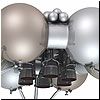

)
)
)
)
)
)
)
)